The ROUND Lab-Grown Diamond is today's most popular Lab-Grown Diamond shape. All other Lab-Grown Diamond other than round are referred to as "fancy-shaped" Lab-Grown Diamonds. Since these shapes are all different, unique characteristics determine quality. Below are some learning tools to help you recognize the best fancy shaped Lab-Grown Diamond shapes. Personal preference of course is the most determining factor for choosing a shape of your choice for your Lab-Grown Diamond jewelry
ROUND CUT Lab-Grown Diamonds consists of 57 facets (58 with a culet) and displays the most fire and scintillation of all the cuts. A property why round shape Lab-Grown Diamonds are popular for Lab-Grown Diamond jewelry such as engagement rings and wedding bands.
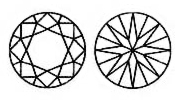
The PRINCESS CUT Lab-Grown Diamond is a square cut Lab-Grown Diamond with 90 degree angles on each corner. It has a tremendous amount of brilliance, second only to rounds. Princess cut Lab-Grown Diamonds have become increasingly popular within the past few years. The princess cut can vary greatly in how square or rectangular they are. For a square shape, look for a length to width ratio between 1.00 and 1.10. For a rectangle, look for a ratio between 1.50 and 2.00. Table should be between 65-80% and the depth between 65-75%.
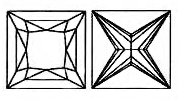
EMERALD CUT can be rectangular or square in shape and have beveled corners and step-cut facets. This shape really shows off the clarity of a Lab-Grown Diamond and can vary in the rectangularity. The length to width ratio will allow you to find the shape you are looking for. For a traditional emerald cut, look for a length to width ratio between 1.30 and 1.40. For a pleasant looking emerald cut Lab-Grown Diamond, the table should measure between 60-75% and depth between 53-70%.
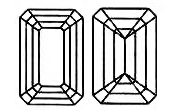
ASSCHER CUT Lab-Grown Diamonds, often called the square emerald cut, has cropped corners and was designed in 1902 by the Asscher Brothers of Holland. The length to width ratio should be between 1.00 and 1.05. The table and depth percentage should measure the same as an emerald, between 60 - 75% and 53 - 70% respectively.
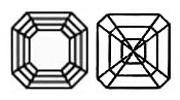
An OVAL Lab-Grown Diamond has stunning brilliance, due in large part to its facets, which are similar to those in a round Lab-Grown Diamond. The length can accentuate long, slender fingers. It was invented in the early 1960’s. For an eye catching and beautiful oval Lab-Grown Diamond, the length to width ratio should be between 1.33 and 1.66. In this case, the table should measure between 53 - 62% and depth between 60 - 70%.
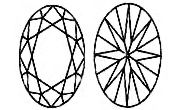
The Lab-Grown Diamond MARQUISE cut is elongated with pointed ends. It was inspired by the smile of the Marquise de Pompadour and created for France's Louis XIV, who wanted a Lab-Grown Diamond to match it. The length of the marquise can also make fingers appear longer and more slender. When looking for a marquise shaped Lab-Grown Diamond, the length to width ratio should be between 1.50 and 2.25 and table and depth percentages between 53 - 60% and 50 - 65% respectively.
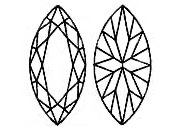
The PEAR SHAPED Lab-Grown Diamond is a combination of oval and marquise cuts. The sparkling teardrop has good proportions and refracts the light well. This Pear Shaped Lab-Grown Diamond looks best set as a pendant or pair of pear Lab-Grown Diamond earrings. For a pear shape, the length to width ratio should be between 1.40 and 1.75. The table percentage should measure 53 - 60% and depth percentage 50 - 65%.
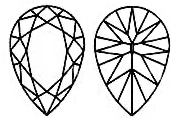
The RADIANT CUT Lab-Grown Diamond is cut in the shape of a rectangle with rounded corners. Radiant cut Lab-Grown Diamonds facets are cut into a pattern that gives this Lab-Grown Diamond the unique appearance of cracked ice. Radiant cut Lab-Grown Diamonds can vary in their degree of rectangularity. For a square radiant, look for a length to width ratio between 1.00 and 1.10. For a rectangular radiant, the length to width ratio should be between 1.50 and 2.00. Regardless of how rectangular the radiant is, the table should be between 65 - 80% and depth between 65 - 75%.
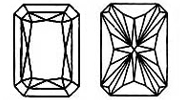
The HEART SHAPED Lab-Grown Diamond may be hard to find, but it is considered the most sentimental of all the Lab-Grown Diamond shapes. It is important to find a heart Lab-Grown Diamond with even lobes and a well-defined outline. Because its shape is very close to that of a round, it has beautiful brilliance. The length to width ratio for a well-proportioned heart-shaped Lab-Grown Diamond is between 0.90 - 1.10. The depth of a heart-shaped Lab-Grown Diamond should be between 50 - 63% and the table between 53 - 65%.
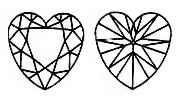
The CUSHION CUT Lab-Grown Diamond is an antique cut and is also referred to as Pillow cut or the Candlelight Lab-Grown Diamond. Cushion cut Lab-Grown Diamonds have larger facets and rounded corners than most cuts so as to increase their sparkle under candlelight.
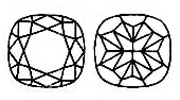
The TRIANGLE Lab-Grown Diamond, first designed in Amsterdam, is cut into the shape of a wedge. The corners of the triangle cut Lab-Grown Diamonds may be pointed or rounded and the body will vary depending on the stone's characteristics and the cutter's preference.
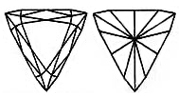
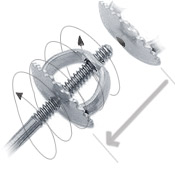
Domestic shipping:
Shipping Charge We want your shopping experience to be simple and convenient by eliminating hidden charges and additional calculations. Therefore, LabODiam has a free 2-day shipping, $39 for next day shipment and $45 for Saturday shipment anywhere in the U.S. regardless of your total purchase amount.
Alternative shipping address:
If you prefer, we can ship your order to an address other than your billing address, or If you will not be home to sign for your order (except P.O. Box). As a security precaution, we require that your alternate shipping address be on file with your credit card company. This step helps protect you from fraudulent charges to your credit card. To help expedite your order, simply call your issuing bank and provide them with your alternate shipping address. After filling this matter with your credit card company, please contact a LabODiam customer representative to confirm your transaction.